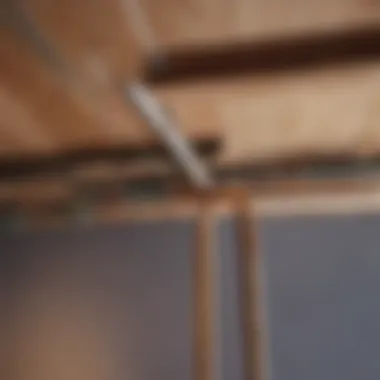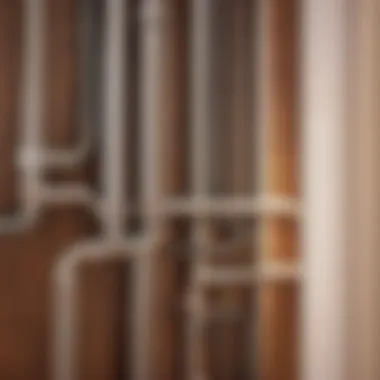Unlocking the Secrets of Residential Electrical Conduit Systems: A Comprehensive Guide


Materials:
-
- Electrical conduit pipes: Purchase durable PVC (polyvinyl chloride) pipes in varying lengths - 1/2 inch and 3/4 inch diameters are commonly used in residential settings.
-
- Conduit fittings: Acquire a selection of fittings including elbows, connectors, couplings, and straps for securing the conduit to walls.
-
- Electrical wires: Ensure you have the appropriate gauge and type of wires for your specific electrical needs.
-
- Conduit glue: Invest in PVC conduit glue to securely connect fittings and pieces of conduit together.
-
- Tape measure and marker: Use these tools to accurately measure, mark, and cut conduit to the required lengths.
-
- Hacksaw: A hacksaw will be necessary for cutting conduit pipes to size.
-
- Cordless drill: Utilize a cordless drill for mounting conduit straps and securing conduit in place.
-
- Screwdriver: Have a screwdriver on hand for attaching fittings and straps.
-
- Level: Ensure installations are straight and level with the help of a spirit level.
-
- Safety gear: Wear appropriate safety gear including goggles and gloves when working with electrical components.
DIY Steps:
- Planning: Begin by mapping out the areas where you intend to run electrical conduit, noting any bends or turns that may be necessary.
- Gathering Materials: Gather all the necessary materials listed above, ensuring you have everything needed for the project.
- Measuring and Cutting: Use a tape measure and marker to measure and mark conduit lengths accurately. Cut the conduit to the required lengths using a hacksaw.
- Assembly: Fit the conduit pieces together using the appropriate fittings and glue to create a continuous conduit system.
- Installation: Secure the conduit to walls using straps, ensuring a neat and tidy appearance.
- Wiring: Thread electrical wires through the conduit, ensuring they are correctly routed and secured in place.
- Completion: Once all wiring is in place, finalize the installation by connecting wires to electrical outlets or fixtures.
Technical Aspects:
- Tools: The key tools for this project include a cordless drill, hacksaw, screwdriver, and level for precise installations.
- Timing: Depending on the scale of the project, allocate sufficient time to complete each step accurately.
- Techniques: Ensure fittings are securely attached, conduits are level, and wires are correctly routed for a safe and effective installation.
DIY Project Process:


- Detailed Installation Method: Follow the step-by-step guide outlined above for systematic and efficient conduit installation.
- Key Techniques and Timings: Pay attention to detail when fitting conduit pieces together, securing them in place, and routing wires for optimal functionality.
- Troubleshooting Tips: In case of errors or challenges, refer to online resources or consult with a professional to rectify any issues promptly.
Introduction


In the realm of residential electrical systems, the role of electrical conduit stands out as a crucial element ensuring safety and efficiency. Electrical conduit serves as a protective pathway for electrical wires, safeguarding them from external elements and preventing potential hazards within homes. Understanding the nuances of electrical conduit is essential for homeowners to maintain a secure electrical setup. This introductory section sets the stage for a detailed exploration of residential electrical conduit, shedding light on its significance in ensuring a reliable and safe electrical infrastructure.
Understanding Residential Electrical Conduit
Importance of Electrical Conduit in Homes
The importance of electrical conduit in homes cannot be overstated. It provides a shield for electrical wires, shielding them from physical damage and environmental factors. This protection is vital in preventing electrical shorts, fires, and other safety risks. By enclosing wires in conduit, homeowners can enhance the longevity of their electrical system and minimize the need for repairs or replacements. The durability and insulation properties of electrical conduit make it a popular choice for safeguarding wiring in both new constructions and renovations. Additionally, conduit facilitates organized and structured wiring layouts, simplifying maintenance and troubleshooting processes.
Role of Conduit in Electrical Wiring
The role of conduit in electrical wiring is pivotal for maintaining a secure and functional electrical network. Conduit not only shields wires but also acts as a pathway for cable management, facilitating the routing of wires throughout the house. This organized arrangement supports efficient maintenance and repairs, allowing easy access to wires when needed. Furthermore, conduit plays a crucial role in grounding methods, ensuring the safety of the electrical system by providing a designated path for electrical faults to dissipate safely. The versatility of conduit in accommodating different types and sizes of wires makes it a versatile and indispensable component in residential electrical setups.
Key Benefits of Using Electrical Conduit
Protection of Electrical Wires
Protecting electrical wires is paramount in ensuring the longevity and safety of an electrical system. Electrical conduit shields wires from physical damage, environmental exposure, and potential hazards. By encapsulating wires within conduit, homeowners can mitigate risks of electrical malfunctions and fires, safeguarding both their property and inhabitants. The rigid structure of conduit provides a sturdy barrier against impacts and external elements, reducing the likelihood of wire wear and tear.
Enhanced Safety Measures
Emphasizing safety in electrical installations is imperative, and electrical conduit plays a key role in enhancing safety measures. Conduit reduces the risk of accidental contact with live wires, minimizing the chances of electric shocks and hazards. Additionally, conduit aids in the early detection of wiring issues, allowing prompt maintenance and repairs to prevent electrical emergencies. By incorporating electrical conduit into residential wiring systems, homeowners can elevate the safety standards of their living spaces and promote a secure environment for their families.
Types of Residential Electrical Conduit


In this article, we delve into the essential topic of Types of Residential Electrical Conduit, a critical aspect of electrical systems in homes. Understanding the nuances of different conduit options is key to ensuring the safety and efficiency of your electrical setup. By exploring the diverse range of conduit types available, homeowners can make informed decisions that align with their specific needs and requirements.
Metal Conduit Options
Rigid Metal Conduit (RMC)
Rigid Metal Conduit (RMC) stands out as a robust and reliable choice in the realm of electrical conduit. Its primary characteristic lies in its rigid structure, providing substantial protection to electrical wires from external factors. This conduit type is favored for its durability and ability to withstand challenging environments, making it a top pick for installations that require heightened security. Homeowners opt for RMC due to its exceptional strength and resistance to damage, ensuring long-term reliability in safeguarding electrical wiring.
Intermediate Metal Conduit ()
On the other hand, Intermediate Metal Conduit (IMC) strikes a balance between flexibility and durability. Known for its lightweight yet sturdy composition, IMC offers a versatile solution for various wiring applications. A key feature of IMC is its ease of installation, making it a popular choice for both residential and commercial projects. While IMC may lack the extreme ruggedness of RMC, its adaptability and manageable weight make it a practical option for many homeowners seeking a reliable conduit system.
Non-Metal Conduit Varieties
PVC Conduit
PVC Conduit emerges as a go-to option for those looking for a corrosion-resistant and affordable conduit solution. Its key characteristic lies in its non-metallic composition, ideal for areas prone to moisture or chemical exposure. PVC conduit is favored for its lightweight nature, simplifying both handling and installation processes. Despite its plastic construction, PVC conduit maintains high durability and offers adequate protection to electrical wiring, making it a cost-effective choice for residential settings.
Flexible Conduit
Flexible Conduit presents a versatile alternative for applications requiring bendability and adaptability. Its primary feature is its ability to flex and contour to various shapes and angles, accommodating complex wiring layouts with ease. Homeowners favor flexible conduit for its straightforward installation and capability to navigate tight spaces where rigid conduits may struggle. While flexible conduit provides enhanced maneuverability, it may require additional supports to maintain stability and protection for enclosed wires.
Installation Process
Residential electrical conduit installation process is a crucial aspect of ensuring the safety and efficiency of electrical wiring in homes. Proper installation not only protects the electrical wires but also enhances the overall functionality of the electrical system. In this section, we will delve into the key elements, benefits, and considerations surrounding the installation process.
Pre-Installation Steps
Planning and Designing Conduit Routes
Planning and designing conduit routes play a pivotal role in the successful installation of residential electrical conduit systems. This stage involves mapping out the paths that the conduits will follow throughout the house, taking into account factors such as the layout of the home, the location of electrical fixtures, and any potential obstacles that may impede the conduit's placement. By meticulously planning and designing conduit routes, homeowners can streamline the installation process and avoid costly mistakes.
Acquiring Necessary Tools
Acquiring the necessary tools is essential for a smooth and efficient installation process. From conduit benders to fish tapes, having the right tools on hand can significantly simplify the installation of electrical conduits. Ensuring that all tools are readily available before commencing the installation process can help prevent delays and ensure that the job is completed accurately and efficiently.
Execution of Installation
Cutting and Measuring Conduit Lengths
The precise cutting and measuring of conduit lengths are critical steps in the installation process. Accurately measuring and cutting conduits according to the planned routes ensure a proper fit and alignment, reducing the risk of future issues such as obstructions or misalignments. This meticulous approach to cutting and measuring conduit lengths is essential for a seamless and effective installation.
Securing Conduit in Place
Securing the conduit in place is another essential step in the installation process. Using appropriate fittings and supports, homeowners can ensure that the conduits are firmly anchored and safely positioned along the designated routes. Properly securing the conduit not only enhances the aesthetics of the electrical system but also guards against potential damage or dislodgment, promoting longevity and optimal performance.
Electrical Wiring within Conduit
Proper Cable Management
Proper cable management within the conduit is paramount for organizing and safeguarding the electrical wiring. Neatly arranging the cables within the conduit not only facilitates future maintenance and troubleshooting but also reduces the risk of tangling or interference between wires. Implementing effective cable management practices ensures a tidy and well-organized electrical system, promoting efficiency and ease of access.
Grounding Methods
Grounding methods play a crucial role in ensuring the safety and proper functioning of electrical conduit systems. Grounding helps dissipate excess electrical current and prevents the buildup of voltage that could lead to electrical hazards such as shocks or fires. By employing effective grounding methods within the conduit system, homeowners can significantly enhance the safety and reliability of their electrical setup, providing peace of mind and compliance with electrical regulations.
Maintenance and Troubleshooting
In the realm of residential electrical conduit systems, the section focusing on maintenance and troubleshooting plays a crucial role in ensuring the longevity and proper functioning of the electrical setup in your home. By maintaining and addressing issues timely, you can prevent electrical faults, ensure safety, and uphold the efficiency of your system. This section will delve into specific elements, benefits, and considerations regarding the maintenance and troubleshooting of your residential electrical conduit.
Regular Inspection Practices
Checking for Damage or Corrosion
When it comes to regular inspection practices for your electrical conduit system, one key aspect to pay close attention to is checking for any signs of damage or corrosion. This step is vital in identifying potential weaknesses or faults in the conduit that could lead to electrical hazards or system failures. By thoroughly examining the conduits for any visible damage or corrosive spots, you can proactively address issues before they escalate, ensuring the safety and reliability of your electrical setup.
It is essential to understand the key characteristic of checking for damage or corrosion, as it allows you to detect early warning signs of potential problems within the conduit system. The thorough inspection for damage or corrosion provides valuable insight into the overall condition of the conduits, helping you make informed decisions regarding maintenance or repairs. While this process may require time and precision, it is a beneficial practice that enhances the longevity and functionality of your residential electrical conduit.
Ensuring Proper Sealing
Another critical aspect of regular inspection practices is ensuring proper sealing of the conduits. Effective sealing is essential for preventing moisture ingress, dust accumulation, or pest intrusions into the conduit system, which can compromise its integrity and safety. By checking and maintaining proper sealing measures, you can safeguard the electrical wires within the conduits, minimizing the risk of short circuits or insulation damage.
The key characteristic of ensuring proper sealing lies in its role in protecting the internal components of the conduit from external environmental factors. Proper sealing not only enhances the safety of the electrical setup but also contributes to the overall efficiency and performance of the system. While the process of ensuring proper sealing may require attention to detail and periodic checks, its advantages in preventing potential hazards and ensuring the smooth operation of your electrical conduit are invaluable.
Addressing Common Issues
Dealing with Blockages
When common issues arise in your residential electrical conduit system, one prevalent challenge is dealing with blockages that hinder the flow of wires or disrupt the functionality of the system. Addressing blockages promptly is crucial to maintaining the seamless operation of your electrical setup and preventing any disruptions in power supply. By identifying and clearing blockages efficiently, you can restore the full functionality of the conduits and ensure a continuous and stable electrical supply throughout your home.
The unique feature of dealing with blockages lies in its ability to troubleshoot and resolve obstructions within the conduit system, allowing for uninterrupted electricity flow. While addressing blockages may involve intricate procedures or professional assistance in complex cases, the benefits of resolving these issues promptly ensure the optimal performance and reliability of your electrical conduit system.
Repairing Damaged Conduit
In instances where the conduit sustains damage due to wear and tear, external forces, or environmental factors, repairing the damaged sections becomes imperative for maintaining the integrity of the electrical setup. Repairing damaged conduit involves assessing the extent of the damage, replacing or repairing affected parts, and reinstating the conduits to their optimal working condition. By addressing and rectifying damaged sections, you can prevent safety hazards, electrical malfunctions, and potential system failures within your residential electrical conduit.
The key characteristic of repairing damaged conduit lies in its impact on restoring the functionality and safety of the conduit system post damage occurrence. Whether through patching, replacing, or realigning damaged segments, the repair process aims to eliminate vulnerabilities and ensure the smooth transmission of electrical currents within the conduits. While repairing damaged conduit may involve technical expertise or adherence to safety protocols, the advantages of a properly restored system reflect in the uninterrupted and secure operation of your electrical setup.
Safety Measures and Regulations
Safety measures and regulations are paramount in the realm of residential electrical conduit systems. Ensuring strict adherence to safety protocols and legal regulations is crucial to safeguarding homes from potential hazards and maintaining the integrity of the electrical infrastructure within a property. By prioritizing safety measures and regulations, homeowners can mitigate risks, protect their loved ones, and uphold the efficiency of their electrical systems.
Compliance with Electrical Codes
Understanding Local Building Regulations
Understanding local building regulations is a fundamental aspect of compliance with electrical codes. It involves familiarizing oneself with the specific rules and guidelines set forth by local authorities regarding electrical installations in residential properties. Adhering to these regulations not only ensures legal compliance but also guarantees that electrical work is performed safely and effectively. Homeowners benefit from understanding local building regulations by facilitating smooth inspection processes and avoiding costly violations. The unique feature of understanding local building regulations lies in its ability to provide a standardized framework for electrical work, promoting consistency and quality in installations.
Ensuring Code Adherence
Ensuring code adherence is a critical step in maintaining electrical safety within a home. By strictly following established electrical codes and standards, homeowners can prevent potential electrical hazards and ensure the longevity of their electrical systems. The key characteristic of code adherence is its focus on promoting best practices and safety guidelines. This choice is advantageous for the article as it underscores the importance of following set regulations to guarantee the security and efficiency of electrical conduit installations. The unique feature of ensuring code adherence is its ability to standardize electrical work, enhancing overall safety and functionality while minimizing risks of malfunction or accidents.
Protection Against Electrical Hazards
Use of Safety Gear
Integrating the use of safety gear is an essential component of protecting individuals against electrical hazards. Safety gear such as gloves, goggles, and protective clothing shields individuals from potential shocks, burns, and other injuries during electrical work. The key characteristic of safety gear is its ability to provide a physical barrier between the individual and electrical currents, preventing accidents and ensuring user safety. Incorporating safety gear is a popular choice for this article as it emphasizes the significance of personal protective equipment in mitigating risks associated with electrical tasks. The unique feature of safety gear lies in its versatility and effectiveness in safeguarding against various types of electrical hazards, making it a crucial aspect of maintaining safety during installations.
Electrical Fire Prevention
Electrical fire prevention plays a crucial role in enhancing home safety and preventing catastrophic events. By implementing fire prevention measures such as proper wiring insulation, circuit overload prevention, and timely maintenance, homeowners can significantly reduce the risk of electrical fires. The key characteristic of electrical fire prevention is its proactive approach to identifying and addressing potential fire hazards before they escalate. This choice is beneficial for the article as it underscores the importance of proactive fire safety measures in maintaining residential electrical systems. The unique feature of electrical fire prevention is its ability to potentially save lives and property by averting dangerous fire incidents, making it a vital aspect of overall safety considerations.
Conclusion
In this comprehensive guide to residential electrical conduit, the conclusion serves as a critical element that ties together all the aspects discussed throughout the article, offering a concise summary and key takeaways for readers. Understanding the importance of proper conclusion in any informational piece is crucial, as it provides a sense of closure and facilitates a clear understanding of the presented material. Within the scope of this article, the conclusion plays a pivotal role in highlighting the significance of residential electrical conduit systems in ensuring the safety, efficiency, and functionality of a home's electrical infrastructure.
By reiterating the key points covered in the preceding sections, the conclusion acts as a final reinforcement of the fundamental concepts related to residential electrical conduit, emphasizing the various types available, the installation processes involved, and the maintenance practices required for optimal performance. It consolidates the information provided, offering readers a holistic view of the subject matter and empowering them with the knowledge needed to make informed decisions regarding their electrical systems.
Moreover, the conclusion serves as a bridge between theory and practical application, guiding readers from the initial stages of planning and installation to the ultimate goal of enjoying a safe and efficient electrical setup within their homes. It underlines the importance of thorough planning, adherence to safety measures, and regular maintenance routines for the successful implementation of electrical conduit systems.
In essence, the conclusion encapsulates the essence of this comprehensive guide, emphasizing the critical role of residential electrical conduit in modern household infrastructure. By delving into the intricate details of this essential component, readers are equipped with the necessary insights to navigate the world of residential electrical conduit systems with confidence and competence.



